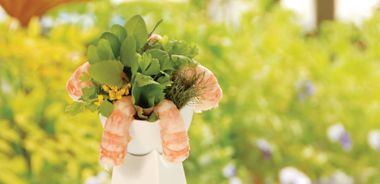Wild Spot Prawns with Ginger Green Onion Sauce, Ponzu Jelly

This might be the first time you work with agar-agar, but it won’t be the last. The ponzu jelly is both citrus fresh and a deliciously fun presentation concept that comes together easily with the agar-agar’s natural bonding properties.
2 lbs (907 g) whole live spot prawns
4 1/4 quarts (4 L) water, salted, boiling
2 cups (500 mL) crushed ice
Place prawns into a large dish and pour boiling salted water over them. Let sit for 2 minutes or until prawns are cooked before pouring off the hot liquid and refreshing the prawns with the crushed ice.
Remove the heads from the tails and reserve the heads to make stock or bisque. Peel the tails and refrigerate prawns until needed.
Ginger Green Onion Sauce
1 Tbsp (15 mL) fresh ginger juice
2 Tbsp (30 mL) finely chopped green onions
2 Tbsp (30 mL) vegetable oil
1 tsp (5 mL) toasted sesame seed oil
Grate fresh ginger into a fine-mesh strainer or cheesecloth and squeeze to make 1 Tbsp (15 mL) of juice. Mix green onions, oils, and ginger juice and let sit for 2 hours to mature.
Ponzu Sauce
1 cup (250 mL) lemon juice
1 cup (250 mL) rice wine vinegar
2 cups (500 mL) soy sauce
1/2 cup (125 mL) mirin
Mix all ingredients and refrigerate.
Ponzu Jelly
1 Tbsp (15 mL) agar-agar powder
3 Tbsp (45 mL) water
4 1/2 cups (1.06 L) ponzu sauce
Dissolve agar-agar powder in water. Mix in with the ponzu sauce, bring to a boil, and cook for 1 minute. Pour into a nonstick mould and chill. When set, cut into desired shapes.
To serve, place prawns atop ponzu jelly and top with the ginger and green onion sauce.
Serves 6.
source: "C Restaurant", alive #298, August 2007




